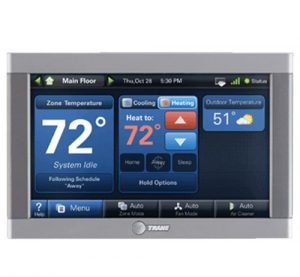Washington can be chilly all year round, but winters are much harsher. Are you going to pay up the nose to stay toasty? That depends. What’s keeping you warm this winter?
You can expect a spike in energy bills if you are still jingle bell-rocking to a single-stage furnace. Much like a one-horse open sleigh, your outdated furnace may run on a single-speed setting all winter long.
A single-stage unit runs and stays on full blast for as long as it is kept on, unlike two-stage furnaces that you may switch to a lower setting after reaching your desired temperature. Let’s discuss what similarities these stage furnaces share and where each outweighs the other.
Single Stage VS Two Stage Furnace
The single-stage and two-stage furnaces are effective heating equipment. Each furnace holds up against outdoor temperatures well, with one furnace doing so more efficiently than the other.
- The single-stage furnace offers users only two settings: FULL POWER and OFF.
- The two-stage furnace provides users with an additional setting: LOWER SETTING.
A two-stage unit has a blower motor that can be turned on, off, and switched to a lower-capacity heat output to maintain your indoor temperature. A single-stage furnace is prone to temperature fluctuations due to its singular blower motor function.
Users might turn their single-stage furnace off when it gets too hot, allowing cold outdoor temperatures to creep back in and leading to temperature swings. Keeping your single-stage furnace on during blistering winter weather may be less hassle than switching it on and off, but it will cost you.
Single Stage Furnaces
Depending on each home’s insulation and outside temperatures, residual heating lasts variably. The single-stage furnace has one blower fan speed. You either have full blast heating or none at all. However, users can stay warm off residual heat after cycling their single-stage furnace off.
If you want to conserve energy, your home might be better off with a furnace offering lower-capacity heating.
Two Stage Furnaces
A two-stage gas furnace goes from high fire to low fire, helping users save on fuel and energy. It’s a practical upgrade from the single-stage gas furnace, which continuously burns fuel. You can switch a two-stage furnace to a lower capacity in the interest of only maintaining indoor temperatures and not further increasing them.
While some require manual shifting, there is a two-stage furnace with an automatic system. Automated two-stage furnaces tend to get overlooked due to a higher price range. However, users save valuable time and energy by not having to adjust the heat themselves, leaving gas valve adjustments to a more advanced model that’s more intuitive for your heating needs.
The two-stage furnace runs on less fuel and energy consumption. While you spend less money on a single-stage furnace, you spend more on its operations in the long run.
Why a Single-Stage Furnace is Less Energy Efficient
A single-stage furnace runs on full power, whether your desired temperature has been reached or not. Some automatically switch off, but that only allows cooler temperatures to creep back into your home, cycling your heating system back on and perpetuating the cycle.
Here is what that might look like:
- Ignition begins to initiate heating.
- Heating is distributed throughout floorboards or ductwork.
- The thermostat linked to single-stage furnaces signals components to cycle off when desired temperatures are achieved.
- Single-stage furnaces are cycled off.
- Your home remains heated based on residual heating.
- Freezing temperatures creep back into your home, shifting indoor temperatures.
- Thermostat signals single-stage furnaces back on at full discharge.
The cycle continues and goes on and on until the end of winter. Automatic one-stage furnaces only automate the cycle, but they don’t make them any more efficient.
Temperature Fluctuations
Switching on and off can lead to temperature swings, leading some homeowners to keep their systems running. While keeping them on prevents cold spots, it is less energy efficient.
Keeping a single-stage model using natural gas burning for longer periods leads to higher utility bills, and the new single-stage electric furnace spikes energy bills. You can keep a variable speed furnace running on a lower setting to reduce energy and utility costs, preventing uncomfortable fluctuations.
Why a Two-Stage Furnace Leads to Energy Savings
Single-stage models are more appealing due to lower upfront costs. A single-stage gas furnace may be incredibly cheap, but even an automatic single-stage furnace isn’t as energy efficient as a manual two-stage one.
A two-stage gas furnace typically has automated systems that adjust the gas valve accordingly. While two-stage gas furnaces still require natural gas, they use less fuel, switching from the first stage to another.
An electric two-stage furnace significantly reduces both utility and energy consumption. These modulating furnaces aren’t too expensive to purchase or install. Unit costs aren’t intimidating, and operational costs come in lower, especially with proper maintenance.
Stable Temperatures
Two-stage furnaces reduce temperature fluctuations by offering users more options. A one-stage furnace only turns on and off, but a two-stage furnace provides a second stage, maintaining a reduced heating output.
The energy efficiency is thanks to the heat exchanger design of a two-stage furnace. Variable speed furnaces have two-stage systems that prevent hot and cold spots from ruining comfortable temperatures, switching between high fire and low fire depending on the heating your home requires.
The two-stage furnace has smarter systems, leading to energy savings, less noise, and better overall air quality.
Improved indoor air quality
While indoor air quality typically measures the number of contaminants in your home, you can define your air quality based on your own comfort and experience. A modulating furnace efficiently prevents erratic warm and cool spots, providing you and your family with lasting warmth and consistent temperatures.
If you constantly experience erratic temperatures, you might consider your air quality low. However, it’s more than just temperatures.
A new furnace, air conditioning system, or heat pump comes with an air filter. Filters prevent more airborne contaminants from entering your living spaces, impacting your home’s indoor air quality.
The right furnace will produce less noise and contaminants, reducing all sorts of pollution in your home.
Are Two-Stage Systems the Most Efficient Furnace?
While a two-stage furnace is more efficient than a single-stage model, they are a distant second to newer modulating furnace types. A two-stage furnace has two variable speeds, while modulating furnaces offer more options.
Modulating furnaces have various stages that differ by only one degree. Its versatile modulation efficiently keeps indoor temperatures more comfortable for longer.
However, the most efficient and sustainable heating and cooling system are known as heat pumps. Heat pumps come at higher unit costs but aren’t as complicated to install or expensive to operate. Geothermal heat pumps are the “greenest” option of all.
Still, heat pumps, multi-stage furnace systems, air conditioners, and other air handlers lose efficiency over time, especially with poor upkeep.
The Importance of Maintaining Your HVAC System
A two-stage furnace is more efficient. Still, no heating system is immune to wear-and-tear. Even a modulating furnace is inefficient without proper maintenance and routine tune-ups.
The right furnace won’t require meticulous upkeep, but regular check-ups should be carried out to avoid compounded issues. Heating and cooling systems must undergo yearly inspections and tune-ups, and it is best to schedule them pre-season.
Pre-season check-ups for furnaces should be right before winter. October is best for residents in Mukilteo, WA, to ensure your furnace is up to bat for freezing winter temperatures.
The worst-case scenario is your furnace breaks down in the middle of winter. You might wait long periods to get your furnace replacement in the middle of sub-zero temperatures. Unfortunately, many homeowners neglect pre-season tune-ups, leading to high demand for furnace repairs.
Please don’t think twice about calling a reputable HVAC technician to check on your equipment, including ductwork and storage. It will save you trouble in the long run.
If you don’t know who to call, we can help you with that.
BelRed Energy Solutions: Heating, Cooling, Plumbing & Electrical
BelRed Energy Solutions has helped Washingtonians with various HVAC, plumbing, and electrical needs for 35 years. You can leave your worries to our reliable professionals.
Our technicians will get your furnace up and ready before winter. If you are looking for more efficient systems, we can help you integrate heat pumps into your home.
If your home has a furnace linked to air conditioning systems, we can give your home a comprehensive inspection to ensure all systems work in unison without a hitch.
Our HVAC technicians are equipped to handle all kinds of AC repair in case your air conditioners require any.
You can book a consultation or schedule an appointment with our reps online.
Call (855) 345-6161
Call our local office for immediate HVAC, plumbing, and electrical concerns.







